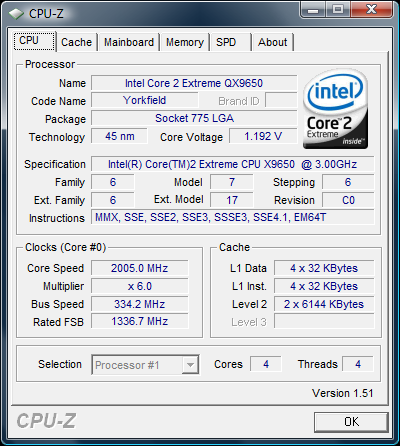Undervolting Your Phenom II And Core 2 Processors
Undervolting Intel's Core 2 Extreme QX9650
Now it’s time to look at Intel’s Core 2 Quad. We used a Core 2 Extreme QX9650, as we did not have a regular Core 2 Quad model at our disposal.
The Core 2 Quad family still delivers lots of performance at acceptable power consumption levels. The Q8000- and Q9000-series are all based on the 45 nm Yorkfield design. Q8000 has 4 MB L2 cache, while the Q9000 family may have 6 MB or even 12 MB L2 cache.
All Core 2 Quad processors are built by using two Wolfdale-type 45 nm dual-core chips.
Default Voltage: 1.256 V
When leaving this BIOS item set to “Automatic”, the voltage was 1.256 V for the Core 2 Extreme QX9650, which led the system to require 185 W at full load.
Default Idle Voltage: 1.192 V
The idle voltage cannot be altered, as it is always based on the default CPU voltage you define. In the case of BIOS defaults, the system ran at 1.192 V idle power once SpeedStep kicked in, reducing the multiplier to 6x, leading to a 2.0 GHz core clock speed. The resulting 94 W idle power (see table below) is still less than the AMD system’s idle power at only 0.96 V and 800 MHz CPU clock, which is interesting.
Get Tom's Hardware's best news and in-depth reviews, straight to your inbox.
Optimized Peak Voltage: 1.072 V
The lowest stable processor voltage was 1.072 V, which we achieved through setting 1.0785 V in the BIOS. At full load, this resulted in a total system load power of only 148 W, which equals a 20% reduction in power consumption through a 16.3% decrease of processor core voltage. Our next step would have been 1.0655 V, which turned out to be unstable. Fortunately, it led to the same idle and load power consumption results, which made further pursuit of more substantial undervolts rather pointless anyway.
Optimized Idle Voltage: 1.008 V (BIOS Configured)
The idle voltage resulting from our 1.0785 V processor voltage setting was 0.1008 V, which helped us reach 87 W system idle power. That’s an improvement of less than 11%, but it’s free and was reliable during our testing.
Summary Table
| Intel Core 2 Extreme QX9650 | |||||
|---|---|---|---|---|---|
| BIOS Voltage | Effective Idle Voltage | Effective Idle Power | Effective Load Voltage | Effective Load Power | Stable |
| auto | 1.192 V | 94 W | 1.25 V | 185 W | Yes |
| 1.1955 V | 1.128 V | 93 W | 1.184 V | 172 W | Yes |
| 1.1695 V | 1.104 V | 92 W | 1.16 V | 166 W | Yes |
| 1.1435 V | 1.008 V | 91 W | 1.136 V | 162 W | Yes |
| 1.175 V | 1.048 V | 90 W | 1.104 V | 158 W | Yes |
| 1.0915 V | 1.016 V | 88 W | 1.08 V | 151 W | Yes |
| 1.0785 V | 1.008 V | 87 W | 1.072 V | 148 W | Yes |
| 1.0655 V | 0.992 V | 87 W | 1.056 V | 148 W | No |
Current page: Undervolting Intel's Core 2 Extreme QX9650
Prev Page Undervolting AMD's Phenom II X4 955 Next Page Test Setup



